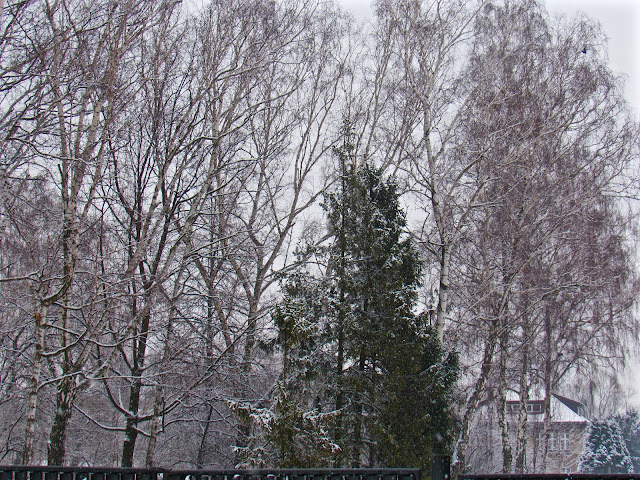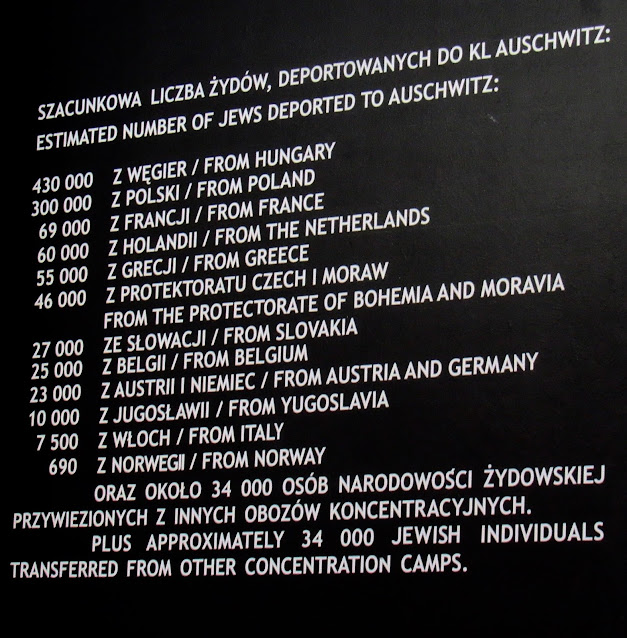Auschwitz
I moved to Israel to intensely study the Holocaust in a graduate program. Obviously, this subject is not a mild or passing interest of mine. After years of reading and studying the most notorious location in human history, I made it in person. It was surreal walking up to these gates.
I can't explain the whole history of Auschwitz in one post. I will try to explain the basics and then talk about our experience visiting.
About one million people were murdered here in the span of a few short years. 90% of the victims were Jews. Most died immediately the gas chambers. The Auschwitz gas chambers could kill 12,000 people per day. Those who weren't killed immediately became slave laborers. Every day was a struggle for survival under horrible conditions. People died from abuse, overwork, starvation, torture, disease, cold, and cruel medical experiments. Most prisoners survived only a few weeks or months at the most.
 |
| The selection of who was going to die immediately was done here near the train tracks. |
 |
At least 5 people crowded onto each bunk in the barracks. This one is 'Block 25,' where inmates were sent before being gassed if they were too sick to work.  |
Here are some of the things that were most striking to me during our visit.
-The extent to which the SS enriched themselves through genocide. They sold every part (hair, gold teeth, prosthetic limbs) and all belongings (clothes, shoes, dishes) of their victims that they could. Jews even paid their own train fare to Auschwitz. It was chilling to witness the organized system the Germans developed to profit from mass murder.
These glass display cases show a small portion what the Nazis stole with the intention of eventually selling. Some items are blackened from fire. As the Soviets were advancing, they attempted to hide their crimes and destroy all evidence.
 |
| Jews were told they were being deported to work camps and packed accordingly to set up their new lives, including these dishes. |
 |
| To avoid panic, those about to be killed were told to label their luggage so they could collect it later. |
 |
| Piles and piles of victims' shoes. Note the children's shoes up front. |
 |
| Glasses. |
 |
| Braces, crutches, prosthetic limbs. |
 |
| Hairbrushes. |
There was also a display case containing TWO TONS of human hair. The Germans used it to make fabric and carpets. Horrifying.
Our tour guide talked about why so few prisoners attempted to escape from Auschwitz. Besides the obvious- electrified barbed wire fences and guard towers- if anyone escaped, that person's ENTIRE work group was immediately shot. I believe the estimate is that there were about 1000 attempted escapes and 100 successful ones.
-The fact that the entire place is a graveyard. The soil itself is filled with ashes and bone fragments.
These 4 gravestones near one of the ruined crematoria are symbolic to remind visitors they are walking in a graveyard.
Several gas chambers were blown up before the Soviets arrived. We walked through one that's still standing. You can see the holes in the ceiling through which the Zyklon B was placed.
 |
| One of the destroyed gas chambers. |
-How close Rudolf Höss's (the commandant's) wife and young children lived to the nearest gas chamber. It was a stone's throw away. After the war, he was hung on these gallows.
 |
| Crematoria as viewed from the Höss home. |
 |
| Home in the corner. |
Unfortunately, very few of the criminals who worked at Auschwitz were punished after the war. For example, after a long life, the "Angel of Death" Mengele had a stroke while relaxing on the beach in South America.
I'll end with some of the information I took pictures of concerning the demographics of the victims.
There was a French survivor visiting with a large group of French Jews while we were there. They prayed for the dead in Hebrew and held up Israeli flags.
I've had the chance to hear from many Holocaust survivors and speak personally with several of them. Every single time, they express gratitude that I was willing and interested to hear their story. They want people to remember.
It's a tough place to visit, but it's so important to be aware what happened here not so long ago.












Comments
Post a Comment